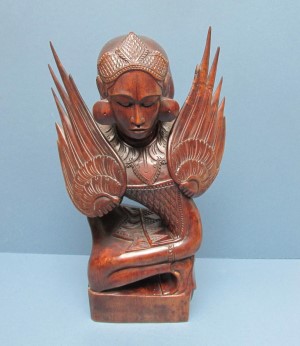
Wooden statue of a legong dancer
1930-1940
Magnificently carved statue of a legong dancer who performs the bird-dance, hence the arm pieces.
The most remarkable feature of this statue is the condition. It survived the long journey from Bali to Holland without damaging the wing tips. How many of these bird dancer statues were damaged? A good guess is probably more than 80%
If one takes a good close look at the wings they are not only razor thin but also carved in an angle, which is very hard to execute without breaking the wood.
The balinese carvers were known to specialise in a genre piece, which they mastered to perfection.
I once owned a similar bird dancer statue which was undoudtedly done by the same master. However that piece was badly damaged.
Pls click on the photo for more info&photos.
|
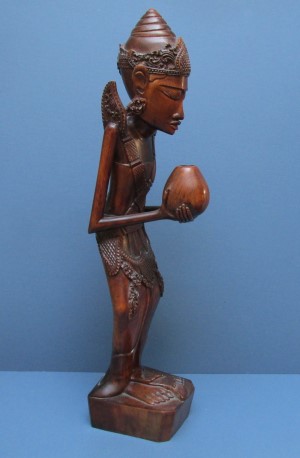
Balinese high priest with container for holy water
1930-1940
Excellent carving from the Pita Maha period(1928-1945). There are beautiful details, like the open-carved container and much detail to the fingers and feet of the priest. The elegant art deco lines are clearly visible. Carved in the expensive satinwood, only used by the best carvers of the village. Finished with a beautiful dark brown patina. Pls click on the photo to get more info and photos.
|
New
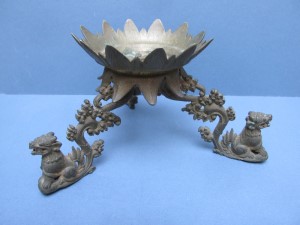
Very rare object, used during holy water rituals on Bali. The Hindu priest will create holy water by handgestures (mudra's) and uttering texts (mantra's). The container with holy water is placed on the tripada.
Please click on the photo for more photos-info.
1850-1900
|
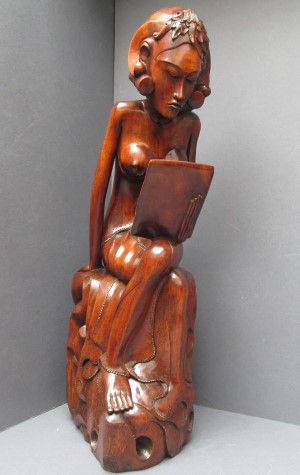
Sitting woman with mirror. Woodcarving from Bali, prewar
1930-1940
Impressive tall statue from the Pita Maha period(1928-1942). Striking elements are the beautiful deco lines that run downwards, and the vegetation-leave-motif on her head scarf. Copying is a normal and accepted thing in Bali, but for a copy you need the orginal. For all the ladies with mirror-carvings, this is probably the preferred original. Each photo can be enlarged two times by clicking on the image.
|

Rare bust of a Indonesian teenager.
1930-1960
Rare bust, probably made on Java, but Bali is possible too. The type of wood is unusual too. The density of the wood allows the carver greater detail, shown here in the facial features. Clicking on the photo will show more photos&info.
NFS; private collection
|
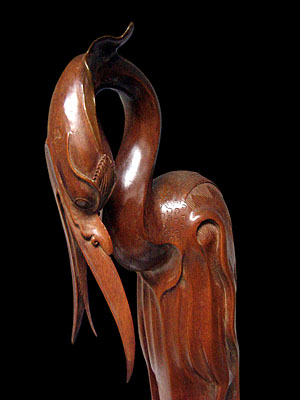
Bird with prey
1930-1940
Bird sculpture with strong art deco features. The twisted neck is very difficult to execute.
|
New

Small but delicate woodcarving done by Balinese master Ida Bagus Tantra.
1950-1960
According to Bali expert Bruce Carpenter it was Tantra who introduced the Botero style on Bali.
Tantra was a nephew of the great Ide Bagus Njana.
Rudolf Bonnet made a portrait of him in 1974, see the last 2 photos.
If you click on the photo there is more info&photos.
|

Charming bust of a young Indonesian girl
1930-1950
Excellent example of a very fine woodcarving technique. When more tourists came to Indonesia after the war, the demand for souvenirs increased considerably. Wooden busts were popular, because they had no protruding parts and were easy to take along in bags or suitcases. On Bali djanger busts became popular by the tourists and therefore mass produced. On Java the loro blonyo, a set of a female and a male bust, were popular as a gift to a newly wed couple. Single busts of a man or woman were less in demand, let alone single busts of young Indonesians. In that respect this bust is remarkable.
|
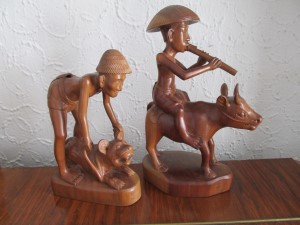
Wooden statues from the mountain village Sebatoe on Bali
1940-1960
These two small woodcarvings were not made for the tourist market but pure folk art. The Sebatoe carvings are meant to be humorous and entertaining, and are carved for fun.
The subjects are often funny observations from the daily life in a village. Often with phantasy animals and/or persons.
Although the Sebatoe carvers made them for fun, the level of artistry is high, which is clearly reflected in these two pieces.
|
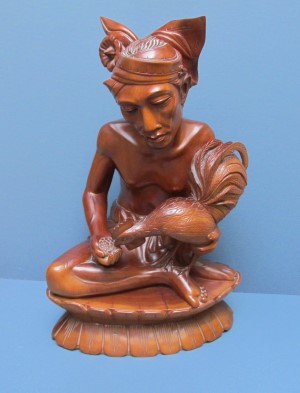
Balinese man with his fighting cock
1940-1960
|
New

Woodcarving of a goat, made in prewar Bali by a anonymous artist.
1930-1940
|
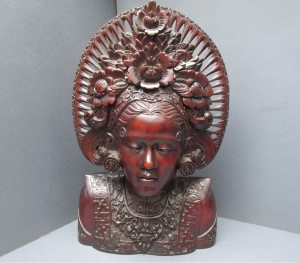
Bust of a djanger dancer
1940-1950
Exquisite large bust of a Balinese djanger-dancer. Many busts like this have been made on Bali but this one is much bigger than usual and also much more detailed. The crown is carved as detailed as possible and the flowers are magnificent. The dress of the dancer has been copied in detail with all the ornaments that are so typical for a djanger-costume. Also the back of the carving is beautiful. Pay attention to the little flowers in her hair! A bust of this size and magnitude is a must for Bali-collectors. Pls click on each photo to see two larger images.
|
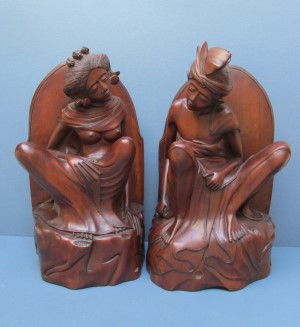
Bookends from the 1950s, made for the tourists on Bali.
Pls click on the photo for more photos&info
1950-1970
These bookends were made by a very accomplished Balinese woodcarver;
many technical hurdles must be overcome.
The last photo shows a similar couple made around the same time.
|
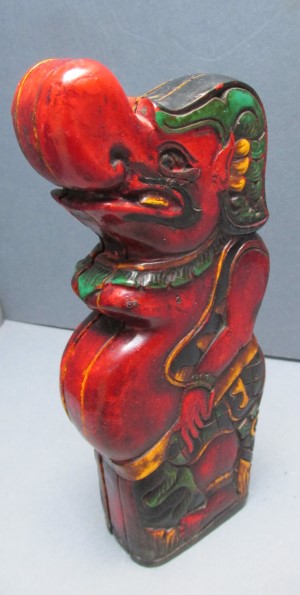
Cockspur case, local name Kotak Taji. Bali, wood
1930-1940
Top piece in the category Kotak Taji. The colours are very well preserved, as is the overall condition. The owner must have been rich, or maybe of royal descent, because this case could contain 16 spurs. This implies he owned a considerable number of fighting cocks. The colour red reflects the status of nobility on Bali. The figure is Twalen, one of four servant clowns from the Hindu Mahabharata story.Twalen is depicted as a hermaphrodite; this reflects how the Balinese look to a god; with a male and female principle. The enlarged nose is regarded as a beauty feature on Bali. Provenance; Old Dutch collection.
Pls click on the photo to get more info and photos.
|

Coloured chalk drawing of Ni Pollok by Adrien-Jean Mayeur de Merpres (1880-1958)
|
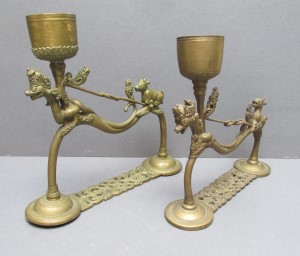
Set of 2 incense burners, used by the Hindu priest on Bali during ceremonies or rituals. Local name; Padamaran
1900-1950
This burner is used by the Pedanda, the Balinese priest, to help him perform certain rituals during ceremonies, like tooth filing, marriage or the blessing of a temple.The two figures are the naga, the holy snake ,at the front, and the nandi at the back. Nandi is the travel animal of Shiva.
The last three photos show a priest performing a ritual with the padamaran in the right hand.
Collectors item.
Pls click on the photo to get more info and photos.
|

A set of two holy water containers
1920-1940
These containers were used to store the holy water. The silver is of a lower standard than the usual standard(960). Holy water is very important in the Hindu religion. It is created through a ritual whereby a pedanda(Bali priest) is in trance, allowing the gods to take possession of the water. The water now has a purifying power. The priest uses this holy water to purify objects and persons to keep the evil spirits away. Because of this important role these containers are richly ornamented and made of silver and sometimes gold.
Pls click on the photo to get more info and photos.
|
New

Woodcarving of a goat
1950-1970
Good example of small carving done by an accomplished artist. This goat was made for the tourist market; no doubt about that. And maybe he was able to finish this in a day. But still such a goat is pretty hard to create, and the result is great; full of class and humor. Maybe Ajun was enjoying himself!
|
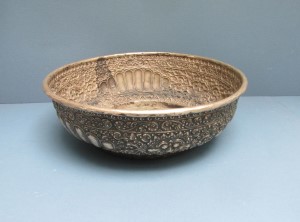
Large silver offer dish
1900-1950
Large offer dish, which was used to bring rice, flowers and fruits to the temple, to appease the gods.
The remarkable feature of this dish is the size. With a diameter of 36 cm this is one of the largest offer dishes used in prewar Bali. This is illustrated in the last three photos.
Please click on the photo to get more info&photos.
|
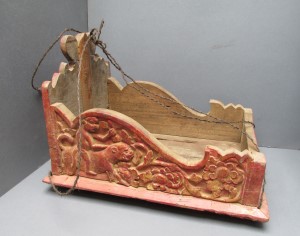
Offering container for new born children. Local name; Sanggah Kumara. Made of wood and rope. Bali, around 1900.
1880-1900
Extremely rare object. This antique offer tray was used to hang above a new born child at the ceiling. That is why the bottom has been carved with the child god Kumara for protection. Inside the tray offers were placed in order to protect the child from evil forces. Such offers could be flowers which colours are white, red, yellow and blue representing the various wind directions. This kind of object is only to be found in musea and private collections. A similar object can be seen on the last photo. Pls click on the photo to get more info and photos.
|

Small oil painting by Fritz Ohl
Nicely subdued oil by Dutch master Frits Ohl of a waringin tree and a person.
Oil on hard board.
Numbered at the back; 222
Pls click on the photo to get more info and photos.
|
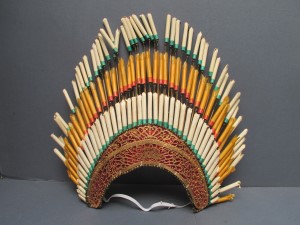
Dance hat used in the Balinese Djanger dance
1940-1960
Extremely rare object.
The Djanger dance is not performed on Bali for many years.
Djanger hats appear seldom on the market.
The hat is made manually with several materials.
Pls click on the photo to get more info and photos.
|
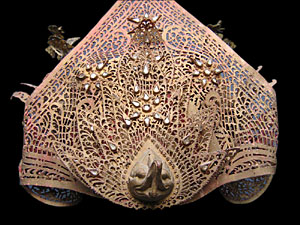
original legong dance crown with neckornament
1930-1940
Written on the inside ; V. ZAREMBA (also the neckornament carries this signature), most likely she was the owner of the dance hat. She was a niece of the famous legong dancer Ni POLLOK.
Made of wood, buffalo-leather, mirrors and bamboo. It must have been a painstaking work to cut all the beautiful ornaments into the leather. Only the best dancers were given this quality of hats.
Rare object because on Bali usually the older hats are re-used by painting them over or fixing new material onto them.
This hat is still in the original form in which it was made as is the original neckornament. Looking at the seize of the neck it is clear that the user was not older than 10-12 years. In pre war Bali only very young girls were allowed to perform the difficult legong dance.
Pls click on each photo to see two larger images.
|
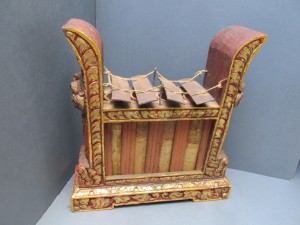
Part of the Gamelan orchestra.
This instrument is called a gender, which is a general name for such a metallophone. The metal plates will resonate with the air in the underlying bamboo poles underneath and subsequently sound is produced. An hammer with a rubber head is used to play the gender. The colour red is often associated with extra-natural powers and the colour gold radiates richdom. The kala heads on both sides of the gender are meant as protection for hostile spirits.
1930-1950
Old and antique instrument which still produces a wondeful sound.
Pls click on the photo to get more info and photos.
|
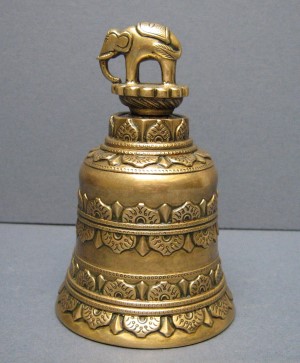
Brass temple bell
Bali, 1st half 20th century
1920-1950
Impressive and heavy shell used by brahman priests on bali during holy ceremonies. Almost an identical shell was depicted in a tourist brochre from 1939. See the last photo.
Pls click on the photo to get more info and photos.
|

Box with animal-flower-wayang pattern. Used for a bible. Made on Java.
1930-1950
Beautifully carved wooden box. These boxes are called 'bible'boxes, because they have the shape of a large book, for example a bible. The woodcarving was done on Java.
The key is still there and te box can be closed and locked.
Pls click on each photo to see two larger images.
|
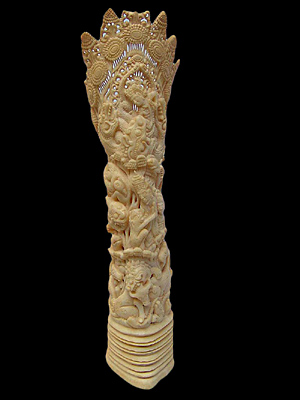
Carved bone.
1930-1940
Magnificent bone carving.
Many motivs are depicted on this bone carving, like animals, demons, floral patterns.
This art work was most likely done by a specialist in bone carvings.
Pls click on each photo to see two larger images.
|
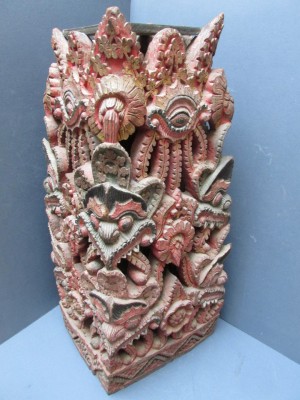
Woorden square support with fine woodcarving used in a bale bale
1920-1940
Nicely carved wooden support, either used as a support for a pillar as part of a bale bale, or as a support for a holy statue.
Pls click on the photo to get more info and photos.
|
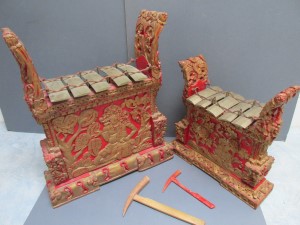
Part of the Gamelan orchestra. This instrument is called a gender, which is a general name for such a metallophone. The metal plates will resonate with the air in the underlying bamboo poles underneath and subsequently sound is produced. An hammer with a rubber head is used to play the gender. The colour red is often associated with extra-natural powers and the colour gold radiates richdom.
1950-1970
Two gamelan instruments with beautiful sonor sound.
Special attention to the detailed woodcarving!
Pls click on the photo to get more info and photos.
|
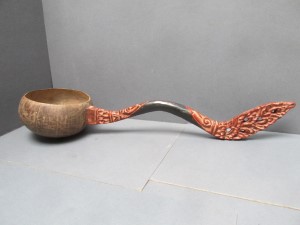
Water scoop with a handle decorated with ornaments. Prewar. Very rare object.
Local name; Gayung
1910-1940
Rare water scoop from prewar Bali. A coconut has been cut in half to create the container for the water. Sometimes in prewar bali even simple household objects, like this one, are decorated with carved motivs.
The last photo depicts a Balinese girl with a typical ordinary water scoop. The photo was taken around 1930.
Pls click on the photo to get more info and photos.
|
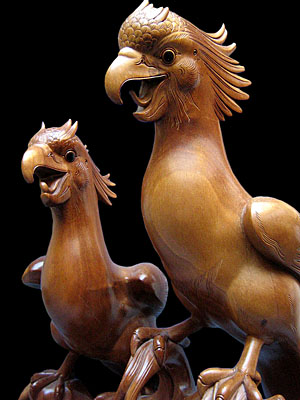
2 parrots on a base with their offspring
1940-1950
Nice birdsculpture of 2 parrots with their offspring. Probably made as a special request of a Dutchman. Made on Bali or Java during the 1940s. Heavy wood.
Pls click on each photo to see two larger images.
|

Houten beeld van een panter, gemaakt op Bali
1950-1970
Good example for a correct wood choice by the carver. By choosing pallissander wood, with its distinctive flamed pattern, it resembles the outerskin of the panter.
A carving full of expression!
Pls click on the photo to get more info and photos.
|

Bell/Gong, made in Java
1930-1940
Very nice detailed gong, carved in the famous jarapara style. the most remarkable thing is that the gong is completely intact. There isn't the slightest damage. Beautiful ornaments of floral patterns and wayang figures.
A similar gong can be found in the Nusantara Museum (Delft) and the Gemeente Museum in Den Hague.
Pls click on each photo to see two larger images.
|

Wooden rice beater from Bali. Local name; panaptapan
1900-1950
Antique object from the Bali before 1950. These ricebeaters were used after the harvest to flatten the top surface of a bundle rice arens, before these bundles were taken to the rice barns. The use of these ricebeaters stopped when new types of rice were introduced in Bali around 1970. On one side of the ricebeater an image of Dewi Sri, goddess of the rice, has been carved. No doubt to ensure a rich harvest. Pls click on the photo for more photos and info.
|
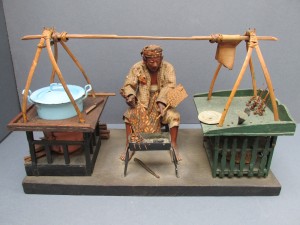
Javanese foodstand
1920-1940
Well preserved image of a Javanese foodstand, a sate seller. Before the war these sellers were abundant on the Streets of Batavia!
Pls click on the photo to get more info and photos.
|
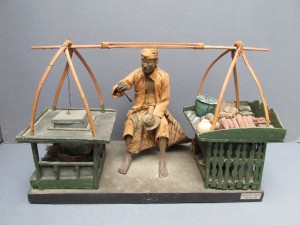
Javanese foodstand
1920-1940
Well preserved and rare marquette of a Javanese foodstand.
Materials used; wood, tin, terra cotta, bamboo, batik.
Pls click on the photo to get more info and photos.
|
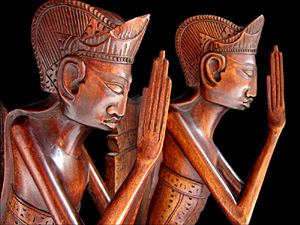
Wooden bookends made on Bali.
1930-1940
Nice pair of bookends, executed in the Art Deco style. This pair is slightly different than the other pair in the Tobo Art collection (TOBO-00018).
Pls click on each photo to see two larger images.
|
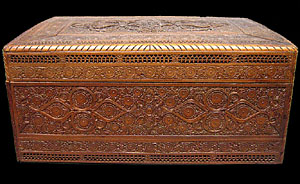
Wooden box with an islam-text carved on top. Made in Sumatra, Indonesia.
1930
Very interesting box, used to store a handwritten Koran.
Pls click on each photo to see two larger images.
|

Carved bone from a deer antlers
1940-1950
Bone sculptures are known on Bali, made of the bones of the cow, usually the height is 21-24 cm. This tall bone carving is made from the antlers of a deer. Probably the artist found the antlers in the forest and decided to make it into an artwork. Hence the unique character of this work, which required days/weeks to finish looking at the many figures and ornaments on the carving.
Pls click on each photo to see two larger images.
|
New
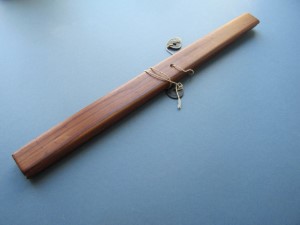
Lontar manuscript 1930-1940 from the collection of Prof C Bonne (1891-1948). Prof Bonne was professor at the Medical School in Batavia, and editor of the Medical Magazine in the Dutch Indies.
1930-1940
This remarkable lontar came from the collection of Prof C Bonne. He was an important doctor in the Dutch Indies.
The very detailed drawings depict scenes from the Ramayana acoompanied by Balinese words.
This was no touristic item, but more a show of force by an experienced (most likely) Balinese lontar writer.
Important lontars had covers made of expensive wood, and the side of leaves were painted red, like this one.
In some cases even a special box was made to preserve the lontar, like in TOBO 753 and TOBO 800.
|
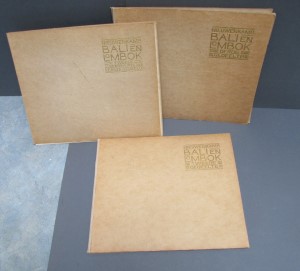
Book "Bali en Lombok" in three parts by W.O.J. Nieuwenkamp, 1906
1906
Limited edition of 400 copies.
This book has numbered 24.
Ex-libris; Jan Veth
First major publication about prewar Bali
Pls click on the photo to get more info and photos.
|
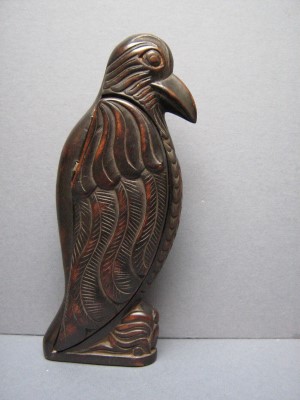
Nicely carved cockspur case, Kotak Taji, in the shape of an owl.
Lombok, wood, before 1940.
1925-1940
This case is a good example of pure folk art. This was not a decorative object, but at the time in use during the cock fighting. The middle panel shows a deer, most likely to bring the owner luck.
In the case there is room for 6 spurs.
A similar case is shown in the standard book about cockspur cases by Pieter van Donk, Indonesian Cockspur Cases, on page 52.
Pls click on the photo for more info&photos.
|
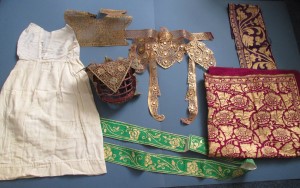
Complete dance costume of a Balinese legong dancer. Prewar
1900-1940
Well preserved costume.
This costume was sent to an English dance institution, where they studied the various Asian dances.
Including the original dance crown and dance fan.
In 1936 a book was published "Temple dances of Bali" by the Swedish artist Tyra Kleen, which shows the various costumes of the legong-dance.
Please click n the the photo for more photos and info.
|

Garuda as temple guard
1930-1940
Impressive statue of Garuda, important figure in the Hindy mythology. This garuda is made by the same carver as the garuda of Tobo 298.
Remarkable is the fact that this statue has survived the transition from Bali to Holland better than the 298-item. Only some minor cracks. Over all in fine condition.
|
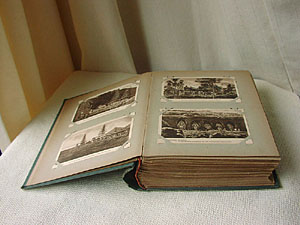
Album with old picture postcards of Bali (1920-1930).
1920-1930
These postcards, also known as 'EAG-kiekjes', were the very first postcards depicting Bali in photographs. They date 1920-1930.These postcards were sold in small envelopes, each containing 10 postcard. Each envelope has a theme, like 'rice culture', 'local arts', 'temples'. Nine such envelopes are part of this collection. See the last photos.
Extremely rare.
Pls click on the photo to get more info and photos.
|